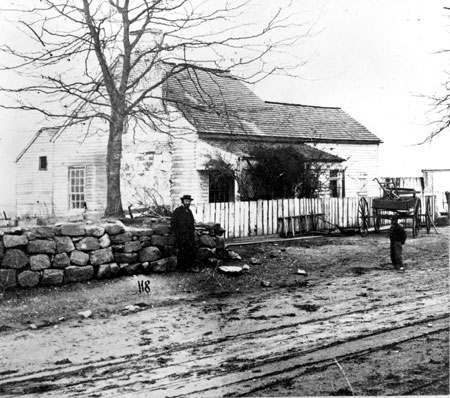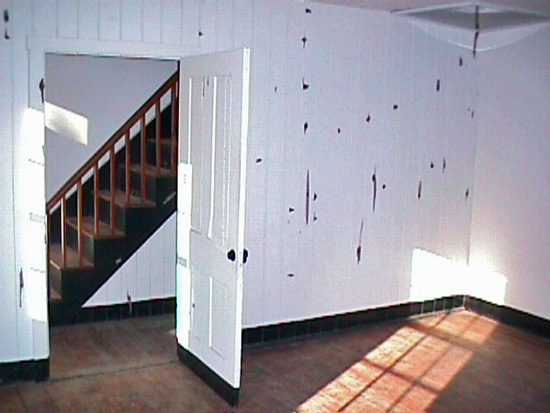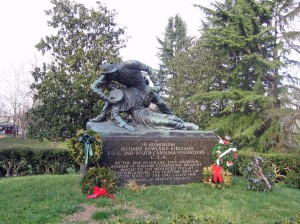…”I depart as Air”…”You will hardly know who I am”…
missvirginia on Oct 28th 2009
This is wonderfully done! I think this creates a link, a bridge between Whitman and today in such a visual, and musical way. The music, the videography. I’m in love. This is probably what I’ll use as a model for my project.
Filed in Uncategorized | 3 responses so far
Virginia for October 27th
missvirginia on Oct 25th 2009
We do a lot of joking and poking fun at Walt’s sexuality and his lovers, yet we also realize that it has so little to do with him, HIM, who he is to us. His infatuation with Lincoln has also been the butt of many jokes in our class. It is humorous, and especially hilarious when imagining him having intense “eye sex” with A. Linc. Whatta stud. In “Memories of President Lincoln”, I moved beyond the tittering and giggling of imagining Walt and Abe in a love triangle with Mary Todd (what, with all her crazy seances and such). I realized that Walt’s love and cherishment of Lincoln was much like my admiration of my grandmother. She died when I was six, and was not someone I knew. I, of course, met her, but I have no recollections of memories, traditions, anything with her. Yet, despite people having diverse views of whether she was a nice person or not, deserving my admiration, I love her.
This sort of blind love for acts read about, pictures seen of, and rumours divulged, it creates a very intimate relationship, albeit one-sided. Whitman did not personally know Lincoln at all (at least that is what our records show), but this blind, one-sided admiration perhaps persuaded his readers to look at Lincoln with more understanding, kinder eyes. Especially with the religious language in “Lilacs” and “O’ Captain”, the trinities, the birth vs. death imagery, all create venues for the reader to connect with Lincoln, via Whitman. “O ever-returning spring! trinity sure to me you bring; Lilac blooming perennial, and drooping star in the west, And thought of him I love.” This one stanza contains both aforementioned points that Whitman used, and then some. Here, Whitman compares Lincoln to a “drooping star in the west”; incidentally, stars have a long, fruitful life, but when they go out, they pretty much collapse upon themselves, they die but leave a white dwarf behind. This white dwarf remains and (theoretically) continue to evolve into a black dwarf. I’m 99.9% positive that Whitman had no idea that his comparing Lincoln to a star, drooping in the west, would be so intense. Lincoln’s life, death, and legacy, leave him as an evolving, ever present, white dwarf.
Though we have read quite a bit of Walt’s poetry, his love in “Calamus” and the love he writes in letters about being a nurse are not comparable to his love in drum taps. The “Yeaaahhh, lets get this over with and reunify the nation” tone is contagious and most like the type of love conveyed in “Memories”. It is an exalted love, a love that realizes this national character is a man with faults, but because of being so real, becomes even more unique and desirable. Lincoln provides a unity that Whitman lacked his whole life. His father was rather absent, his family was poor, he had several siblings that were less than successful (including one that had some sort of mental impairment). With his family life as less than desirable, I think Lincoln represented a unified nation to which Whitman could father with his poetry, nursing, and love.
Filed in Uncategorized | 4 responses so far
Fredericksburg FieldTrip
missvirginia on Oct 23rd 2009
Field trips have classically been (for me, anyway) painfully boring, filled with bratty kids who I didn’t like, and full of humiliation if my parents attended as chaperones. Thankfully, we’re in college so our parents won’t be attending, we don’t go to school with bratty kids (well…haha, just kidding), and now the field trips are in something so terrifically engaging that you just might be heavily judged if you say it was boring. Obviously, our field trip in Fred. was AMAZING. I have never felt so engaged in history before.
The walking tour was pretty cool, our guide, LeeAnn (?), was so knowledgeable and easy to talk to. The most interesting thing were the Innis and Stephens Houses. Only the Innis house was still standing, and had even been lived in up until the 1970s!! Crazy! Even though the house was closed to the public, it had many windows that we could see in, and we could see the bullet holes peppering one of the walls, and even outside the house there were a few bullet holes (or very large woodpecker holes). It was so surreal to be standing there, faces pressed up against the glass, imagining Martha Innis running back and forth between the two houses (I’m sure she did that as little as possible during the actual battle right on her front stoop), trying to get water and food to the soldiers needing it.
 these pictures are from the NPS, since I only had the flipcam and not an actual camera.
these pictures are from the NPS, since I only had the flipcam and not an actual camera.
 CRAZY!
CRAZY!
As we were standing by the Innis and where the Stephens houses were, I couldn’t help but wonder if the old trees swaying in the warm fall breeze were witness trees. Alas, they weren’t but they were so old, and tall, and their girth was amazing that I think they were planted very shortly after the war. One of the most beautiful things I learned about was the Angel of Marye’s Heights. Richard Kirkland, a soldier from SC, heard a Union soldier calling out for help and asked his superior if he had permission to run onto the battlefield, mind you that’s where bullets were whizzing by and Union soldiers were collapsing from gunfire. Kirkland was allowed to run onto the field and give water and help to the man calling for help. This is his monument. I think that if Whitman could have met this Kirkland fellow and knew of Kirkland’s good deeds, he would be moved.
 After the walking tour on Sunken Rd (by the way, the road was closed to public just a few years ago), we went to the Chatham Mansion, where Whitman wrote about seeing the amputated limbs. In fact, the catalpa trees where the limbs were, loaded up on a buggy with a horse or mule waiting patiently, WERE STILL THERE. I have a video coming soon, if I can figure out how to load it “correctly” to youtube. The Mansion also featured a rather interesting video, not quite as dry as one might expect coming from the NPS (the movie we saw before walking Sunken Road was rather interesting too). I had no idea that the mansion had such an extensive history, being owned and built back before the Revolutionary War. It was first owned by the Fitzhugh’s, then the Jones’, then the Lacy’s (the Civil War owners), when the Lacy’s left, it was abandoned for a while. Vagrants graffitied the walls, which are still shown when touring the house along with other paraphernalia of the Civil War. In fact, the room in which we viewed the movie was the operating room, apparently there are stains on the floor from blood as well (found that on the nation park service website!). After the war, the Lacy’s moved back but were not able to maintain the property appropriately. There were a succession of owners, then the Devore’s owned it in the 20’s and probably had some swinging parties there. The Devores tried to restore the house to its original state, which included altering it so it would pretty much never have the same architecture as when Whitman saw the house. After the Devore’s, the Pratt’s owned the estate then willed it to the NPS.
After the walking tour on Sunken Rd (by the way, the road was closed to public just a few years ago), we went to the Chatham Mansion, where Whitman wrote about seeing the amputated limbs. In fact, the catalpa trees where the limbs were, loaded up on a buggy with a horse or mule waiting patiently, WERE STILL THERE. I have a video coming soon, if I can figure out how to load it “correctly” to youtube. The Mansion also featured a rather interesting video, not quite as dry as one might expect coming from the NPS (the movie we saw before walking Sunken Road was rather interesting too). I had no idea that the mansion had such an extensive history, being owned and built back before the Revolutionary War. It was first owned by the Fitzhugh’s, then the Jones’, then the Lacy’s (the Civil War owners), when the Lacy’s left, it was abandoned for a while. Vagrants graffitied the walls, which are still shown when touring the house along with other paraphernalia of the Civil War. In fact, the room in which we viewed the movie was the operating room, apparently there are stains on the floor from blood as well (found that on the nation park service website!). After the war, the Lacy’s moved back but were not able to maintain the property appropriately. There were a succession of owners, then the Devore’s owned it in the 20’s and probably had some swinging parties there. The Devores tried to restore the house to its original state, which included altering it so it would pretty much never have the same architecture as when Whitman saw the house. After the Devore’s, the Pratt’s owned the estate then willed it to the NPS.
I will try to post the vids from the trip shortly!
Filed in Uncategorized | No responses yet
Virginia for October 20
missvirginia on Oct 19th 2009
I think the best quote that personifies the answer to the prompt questions this week is from Calder’s “Persona Recollections of Walt Whitman”. She mentions that when Whitman heard about a soldier from the West who had never seen an orange, he immediately brought oranges to that soldier on his next visit. I find it similar to his relationship to his readers. Before Whitman, there really wasn’t any poet like him; a poet who wrote of a seductive nature and earth, a mad and violent people who were…us, Americans (almost exclusively in Drum-taps). Whitman saw that none of us had seen these “oranges” of provocative text, so he immediately got to work in order to help us taste the tangy, slightly acidic, and citrusy morsels of the poetry that became a definition of the War and of the people.
In Morris’ book, The Better Angel, I remember reading it this summer and being shocked at Whitman’s view on slavery. It baffled me to think someone who may have been fearful of persecution because of his sexuality, would be somewhat judgmental towards African-Americans. When Morris elaborates on Whitman’s childhood friend who was black, and that he practically was “Uncle Tom”, I felt uneasy. The man who I had thought wanted Americans, ALL Americans, to be free no matter their sex, education, background, origin was a little dashed away in my mind. Morris quotes Whitman’s poetry, “I am the poet of slaves and the masters of slaves, I go with the slaves of the earth equally with the masters and I will stand between the masters and the slaves, Entering into both so that both shall understand me alike.” Morris also tells us that Whitman had equally been not fond of “hotheaded” abolitionists nor of die-hard pro-slavery activists. I feel disappointed in Whitman, I almost feel like he resented both parties, that they both had created the War. However, I think that it would have been utterly impossible to go on the way the country was going. A country cannot have some states allowing something and another few finding the same thing illegal. Today we have medical marijuana and different types of legal alcohol (Everclear, allowed in North Carolina, but not in Virginia), albeit none of those issues are as pressing as human bondage, but it creates a kind of understanding of what is in the present. I think Whitman would have been ecstatic for the country to continue being somewhat divided on the slavery issue, as long as there were a way of working it out beyond war. Again, I think Whitman was somewhat of a dreamer and this is just another well-wished dream of probably many Americans of that time. Whitman still continued to unite the Confederacy and the Union through his poetry and not singling out any extreme, violent enemy, but looking at the soldiers as “our boys” alike, despite their north/south origin.
Filed in Uncategorized | 4 responses so far
Material Culture Museum Entry, Soldiers’ Home
missvirginia on Oct 18th 2009

34-room original building on the Estate
Lincoln’s Cottage, Soldier’s Home
Founding and History of Soldiers’ Home
Founded by a Major General, General, and a Senator on March 3, 1851 after the suggestion of an Army Asylum in his Annual Message to the President in November of 1827 by Secretary of War James Barbour. Thus, it took almost 30 years before action was taken to form the “asylum”.
Brevet Major General Robert Anderson, the supportive Major General who was active in the founding of the home, was Fort Sumter’s commanding officer during the very beginning of the Civil War. Senator Jefferson Davis, the second part of the triumvirate who enacted Barbour’s suggestion, repeatedly introduced legislation to Congress to found a home for retired and disabled American veterans. Thirdly, General Winfield Scott contributed $100,000 of tribute money (a total of $150,000) gained from pillaging Mexico City.
The selling point was “to provide an honorable and secure retirement for American war veterans.” When Congress passed legislation it was considered “a military asylum for the relief and support of invalid and disabled soldiers of the army of the United States.”
Many sites had been considered for Soldiers’ Home, finally George Riggs’ 256-acre family estate was purchased for $57,000 and a Mr. Charles Scrivner gave about 58 acres. More land was added over the next 20 years. Soldiers’ Home was just three miles north of downtown DC (at the time, of course).
Riggs, an affluent DC banker, finished building the “’Corn Rigs’ cottage”, his summer retreat, in 1842. The unusual architecture of the house, including its several gables, latticed windows, and the intricate gingerbread trimming stamp it as being part of the Gothic Revival-style. Gothic Revival was a style then popular country and summer homes.
In 1857, the house’s intended inhabitants, retired soldiers, moved into a new, large stone building. It was near the original cottage and was modeled after the same Gothic style. There were four buildings, including the one aforementioned, by 1861.
Soldiers’ Home in the Civil War
The home was very close in proximity to Fort Slemmer and Fort Stevens. Fort Slemmer was actually one of the forts that skirted DC. Fort Stevens played a key role in defending the District against the Confederates, led by General Jubal Early, in a July 1864 attack. Fort Stevens was visited several times by Lincoln during the Civil War, even when it was under attack; according to some, Lincoln was almost shot while visiting during the attack.
If the walls could talk at Soldiers’ Home, they would be a history book within themselves. In the September of 1862, President Lincoln was residing at the house when he was revising and writing the final draft of his Emancipation Proclamation.
Lincoln and Soldiers’ Home
During the Civil War, Abraham Lincoln and his family lived at Soldiers’ Home seasonally, from June to November in the years from 1862-1864. It is reported that each summer season the Lincoln family lived at Soldiers’ Home, the staff had to transport about 19 cartloads of the family’s belongings from the city. The estate was situated on one of the highest hills in the district. The grounds offered respite from the mugginess and congestion of the capital. There is evidence from the first lady that the family “delighted” in their romps at the home.
Lincoln enjoyed the cool, airy atmosphere of Soldiers’ Home and getting away from the city. Yet, he did bring his work with him. Even when he didn’t bring the work home, every morning he rode to the White House to fulfill his duties as president. He would return each evening to Soldiers’ Home. Lincoln, and the cavalry that accompanied him to and fro, had to pass hospitals, cemeteries and camps for former slaves. Even on his way back to his hide-away from the war, he had to be reminded of the war. Lincoln met with political foes and friends there and discussed military strategy with his advisors. Lincoln visited the “old”, or original building, Soldiers’ Home within three days of his first inauguration.
In the battle at Fort Stevens, like mentioned before, Lincoln went to observe. Considering that the battle of Fort Stevens was only a mile from Soldiers’ Home, the first family had been evacuated to the White House. In that same summer, not only was he the first president to be under enemy fire, but also his commutes to the city and the cottage were the target times for an attempted assassination by a sniper and abduction by John Wilkes Booth.
Soldiers’ Home and Beyond
Before Lincoln, President Buchanan used the estate to escape the city and duties of being head of the nation. After Lincoln, Presidents Hayes and Arthur also stayed at Soldiers’ Home. Hayes stayed at the estate during the summer from 1877 to 1880. Arthur and his family resided there during the White House’s renovations in the winter of 1882 and spent summers there also. Presidents beyond Hayes and Arthur did not use Soldiers’ Home as a retreat.
The home was adapted for new and different uses. In the 1900’s, the home faded into oblivion. Finally in 2001, the Soldiers’ Home was officially named the Washington Unit of the Armed Forces Retirement Home. It is, in fact, the only retirement home for enlisted Army and Air Force personnel, warrant officers, and disabled soldiers in the nation. In 1973, the Secretary of the Interior determined the U.S. Soldiers’ and Airmen’s home a National historic landmark. This included the original cottage and the three other buildings that were build pre-Civil War.
More recently, in 2000, President Clinton declared “the President Lincoln and Soldiers’ Home” a National monument. The new monument consisted of the cottage and 2.3 acres surrounding it. The Nation Trust for Historic Preservation started a detailed and comprehensive restoration of the cottage in 2001. In 2008, for the first time ever, the organization opened President Lincoln’s Cottage to the general public on President’s Day.
Works Cited:
http://www.lincolncottage.org/
http://www.nps.gov/nr/travel/presidents/lincoln_cottage.html
Filed in Uncategorized | One response so far
Virginia S. for October 6th
missvirginia on Oct 5th 2009
Whitman’s triumphant, mostly optimistic, and hopeful tone in his earlier work evokes a sort of nostalgic happiness. Celebrating nature, mother earth, and humanity was the “name of the game” with Whitman. He wasn’t all love and happiness, he mentions horrors of life (like the slave passing through his house and how he put salve on the wounds before the slave ran North) but always with a compatible positive note. Mostly, he combatted the mentioned distasteful situations with his positive effort to make whatever was negative better. He wrote with a tone that rang of human rights, that rang of tolerance and love, of trying to find a common denominator in everyone. The unity that he strove to find, and usually was successful in finding, became changed in Drum Taps.
The voice Whitman writes with in “First O Songs for a Prelude” is tearful, regretful, and the unifying thread for the people of which he writes about. Those people are the ones with losses that they face because of the war; the devastation, the absence of loved ones (whether dead, dying, or gone off to fight in the war), the indignation many people felt when thinking about the “enemy”. I think Whitman’s outlook of the Confederates compromised him. He and the “Angel of Marye’s Heights”, Richard Kirkland, had one thing in common; they felt in their heart of hearts that what they were doing was necessary in both aspects: war and helping humanity, humility, and love survive the cruel reality of battle. Despite the judgement they both faced, they both felt empathy for the “enemy”. While Kirkland brought water to Union soldiers on the battlefield, Whitman ,although conservatively, did mention bravery and courage when writing articles about the battles, soldiers, and sights he saw when with the regiments.
Whitman does not need to change his triumphant “songs”. In fact, that would part of his responsibility, since he was/is the self-proclaimed “Bard of America”. He needs to remain encouraging, however, the question that brings is, who should he encourage. If he encourages the South too much, Northerners might turn their back and call him a sympathizer–then his business would fail, and we all know that Whitman always had one eye on his career. If he coldly turned his shoulder on the Confederacy, I find it hard to believe he could live with himself acting that way. His triumphant tone would be for the nation BEFORE the civil war and to try and strive to gain that unification again. Thus, the triumphant tone mainly needs to shift from a triumphant “Life may be hard, but it is good” tone to a “Life is hard, only love and tolerance will get you through it” voice.
Drum Taps is a loving, vigorously working set of poetry that tugs at the heart strings and makes modern audiences question the modern day wars we are “sending our boys off to fight in”. Is there any national figure rooting for them, regardless of whether they support the war on terrorism or not? No, there is no modern day “angel” in Iraq writing home for soldiers who have their arms, hands, shoulders missing because of an IED. The nation(s) of the Civil War were lucky to have Whitman siding with any lonely boy, whether he was from Georgia, had slaves at home, or from Connecticut, and poor as dirt. The triumphant tone mainly needs to shift from a triumphant “Life may be hard, but it is good” tone to a “Life is hard, only love and tolerance will get you through it”.
Filed in Uncategorized | 7 responses so far
